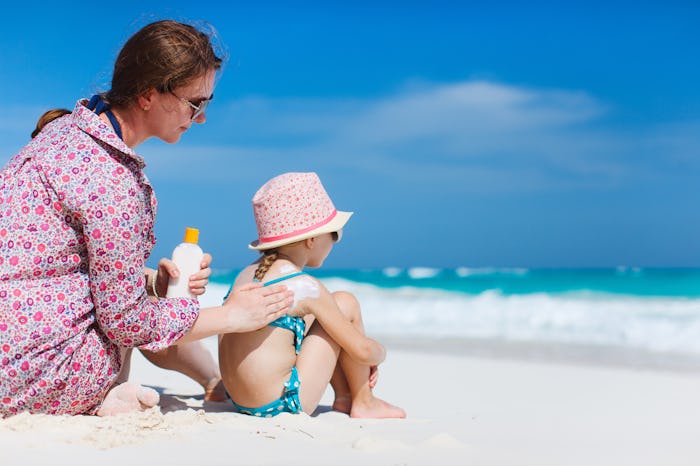Life

The 10 Biggest Sunblock Mistakes Might Not Be As Obvious As You Think
'Tis the season, parents — the season for sunburned shoulders and tantrums over sunblock application, that is. As fun as the long summer days can be with children, its no secret that putting sunscreen on kids is kind of the bane of a parent's existence. Still, what must be done must be done — and if you've got to do it, you'd better do it right. Because the only thing worse than smearing white goo over every square inch of your kid's body is being up all night with them after a burn, and there are some big sunblock mistakes that you definitely don't want to make.
Thankfully, swimwear companies are beginning to wise up to just how much parents loathe the sunscreen application process, and we're seeing more long sleeved rash guards on the market for kiddos as a result. And while it's awesome to easily have their entire torsos covered, you still have to protect their legs, feet, hands, and face — so you'd better be sure you're doing it right.
Not only do you want to avoid the aftermath of a serious sunburn (read: aloe vera gel dried and stuck to the sheets), you of course need to protect your little ones from sun damage, too. Here are the sunblock mistakes you definitely don't want to make.
1Not Using Enough
If you're using a lotion, you'll need to use at least a shot glass worth of sunscreen on your child to be sure you're getting enough, according to Health, but with the newer spray formulas its sometimes harder to tell. Make sure you can see the moisture covering the entire area when you spray, and then be sure to rub it in, even if the bottle says you don't have to.
2Thinking A Higher SPF Means You Can Stay Out Longer
Dermatologists say sunblocks that boast a SPF above 50 give users a false sense of security while not actually performing any better than the lower numbers. The Skin Cancer Foundation recommends a minimum of SPF 30 and a maximum of SPF 50.
3Using Last Year's Bottle
According to an article in Reader’s Digest, every bottle of sunblock has an expiration date and, yes, its actually pretty important that you heed it. But its even more important to note that heat can cause the active ingredients to break down and become less effective, so if your tube has been in your car or garage for months its best to go ahead and trash it.
4Missing The Ears
Best Health says that ears, especially the tops of the ears, are among the most commonly forgotten sunburn spots. Even if your daughter has long locks, her ears will still catch some potentially harmful rays if you aren't careful.
5Applying It At The Pool or Beach
Don't wait until you're already outside to whip out the sunscreen: All members of your family should be lotioned up before you leave the house. Weather.com reminds us that sunscreen takes at least 15 minutes to soak in
6Not Choosing A "Broad Spectrum" Formula
The term "broad spectrum" means the sunscreen will protect against UVA and UVB rays, according to the American Academy of Dermatology. While one causes skin aging and the other causes sunburn, both types can lead to skin cancer. Choose your tube wisely!
7Sweating Or Swimming It Off
If your kid is staying out for more than two hours, reapplying a second or third time is just as important as the first application. But most of us forget that sweating or being in water means sunscreen won't last as long, Real Simple noted, and we'll need a follow up even sooner.
8Not Considering Sensitive Skin
Young children's skin is likely to be more sensitive than yours, so its a good idea to use a different sunscreen for them. The American Academy of Dermatology recommends seeking out active ingredients like zinc oxide and titanium dioxide, or looking for labels that indicate a kid-friendly sunblock formula.
9Not Applying It Before Car Rides
Most windshields protect against the UVB rays that cause sunburn, according to Marie Clare, but side windows don't necessarily do so, and neither block UVA rays, which can still cause cancer. If you're driving around between in the middle of the day, don't forget to lather up your little one in the back seat.
10Skipping It And Opting For Shade Instead
Unfortunately, setting up camp under a beach umbrella or pool awning doesn't give you full protection (not that our kids are too keen on staying in one place anyway). Health has reported that sand and water both actually reflect UV rays, so the harmful effects can still get you when you're least expecting it.